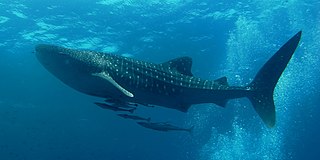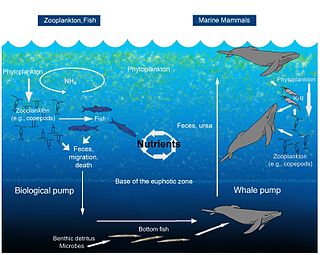
The blue whale is a marine mammal and a baleen whale. Reaching a maximum confirmed length of 29.9 meters (98 ft) and weighing up to 199 tonnes, it is the largest animal known ever to have existed. The blue whale's long and slender body can be of various shades of greyish-blue dorsally and somewhat lighter underneath. Four subspecies are recognized: B. m. musculus in the North Atlantic and North Pacific, B. m. intermedia in the Southern Ocean, B. m. brevicauda in the Indian Ocean and South Pacific Ocean, B. m. indica in the Northern Indian Ocean. There is also a population in the waters off Chile that may constitute a fifth subspecies.

The orca, also called killer whale, is a toothed whale belonging to the oceanic dolphin family, of which it is the largest member. It is the only extant species in the genus Orcinus and is recognizable by its black-and-white patterned body. A cosmopolitan species, orcas can be found in all of the world's oceans in a variety of marine environments, from Arctic and Antarctic regions to tropical seas.

Whales are a widely distributed and diverse group of fully aquatic placental marine mammals. As an informal and colloquial grouping, they correspond to large members of the infraorder Cetacea, i.e. all cetaceans apart from dolphins and porpoises. Dolphins and porpoises may be considered whales from a formal, cladistic perspective. Whales, dolphins and porpoises belong to the order Cetartiodactyla, which consists of even-toed ungulates. Their closest non-cetacean living relatives are the hippopotamuses, from which they and other cetaceans diverged about 54 million years ago. The two parvorders of whales, baleen whales (Mysticeti) and toothed whales (Odontoceti), are thought to have had their last common ancestor around 34 million years ago. Mysticetes include four extant (living) families: Balaenopteridae, Balaenidae, Cetotheriidae, and Eschrichtiidae. Odontocetes include the Monodontidae, Physeteridae, Kogiidae, and Ziphiidae, as well as the six families of dolphins and porpoises which are not considered whales in the informal sense.

The Yellow Sea is a marginal sea of the Western Pacific Ocean located between mainland China and the Korean Peninsula, and can be considered the northwestern part of the East China Sea. It is one of four seas named after common colour terms, and its name is descriptive of the golden-yellow color of the silt-ridden water discharged from major rivers.

The beluga whale is an Arctic and sub-Arctic cetacean. It is one of two members of the family Monodontidae, along with the narwhal, and the only member of the genus Delphinapterus. It is also known as the white whale, as it is the only cetacean to regularly occur with this colour; the sea canary, due to its high-pitched calls; and the melonhead, though that more commonly refers to the melon-headed whale, which is an oceanic dolphin.

Baleen whales, also known as whalebone whales, are a parvorder of carnivorous marine mammals of the infraorder Cetacea which use keratinaceous baleen plates in their mouths to sieve planktonic creatures from the water. Mysticeti comprises the families Balaenidae, Balaenopteridae (rorquals), Eschrichtiidae and Cetotheriidae. There are currently 16 species of baleen whales. While cetaceans were historically thought to have descended from mesonychids, molecular evidence instead supports them as a clade of even-toed ungulates (Artiodactyla). Baleen whales split from toothed whales (Odontoceti) around 34 million years ago.

The humpback whale is a species of baleen whale. It is a rorqual and is the only species in the genus Megaptera. Adults range in length from 14–17 m (46–56 ft) and weigh up to 40 metric tons. The humpback has a distinctive body shape, with long pectoral fins and tubercles on its head. It is known for breaching and other distinctive surface behaviors, making it popular with whale watchers. Males produce a complex song typically lasting 4 to 33 minutes.

The whale shark is a slow-moving, filter-feeding carpet shark and the largest known extant fish species. The largest confirmed individual had a length of 18.8 m (61.7 ft). The whale shark holds many records for size in the animal kingdom, most notably being by far the largest living nonmammalian vertebrate. It is the sole member of the genus Rhincodon and the only extant member of the family Rhincodontidae, which belongs to the subclass Elasmobranchii in the class Chondrichthyes. Before 1984 it was classified as Rhiniodon into Rhinodontidae.

Right whales are three species of large baleen whales of the genus Eubalaena: the North Atlantic right whale, the North Pacific right whale and the Southern right whale. They are classified in the family Balaenidae with the bowhead whale. Right whales have rotund bodies with arching rostrums, V-shaped blowholes and dark gray or black skin. The most distinguishing feature of a right whale is the rough patches of skin on its head, which appear white due to parasitism by whale lice. Right whales are typically 13–17 m (43–56 ft) long and weigh up to 100 short tons or more.

The toothed whales are a parvorder of cetaceans that includes dolphins, porpoises, and all other whales possessing teeth, such as the beaked whales and sperm whales. 73 species of toothed whales are described. They are one of two living groups of cetaceans, the other being the baleen whales (Mysticeti), which have baleen instead of teeth. The two groups are thought to have diverged around 34 million years ago (mya).

The Cuvier's beaked whale, goose-beaked whale, or ziphius is the most widely distributed of all beaked whales in the family Ziphiidae. It is smaller than most baleen whales yet large among beaked whales. Cuvier's beaked whale is pelagic, inhabiting waters deeper than 300 m (1,000 ft). It has the deepest and longest recorded dives among whales at 2,992 m (9,816 ft) and 222 minutes, though the frequency and reasons for these extraordinary dives are unclear. Despite its deep-water habitat, it is one of the most frequently spotted beaked whales.

The four-toothed whales or giant beaked whales are beaked whales in the genus Berardius. They include Arnoux's beaked whale in cold Southern Hemispheric waters, and Baird's beaked whale in the cold temperate waters of the North Pacific. A third species, Sato's beaked whale, was distinguished from B. bairdii in the 2010s.

Cetacean surfacing behaviour is a grouping of movement types that cetaceans make at the water's surface in addition to breathing. Cetaceans have developed and use surface behaviours for many functions such as display, feeding and communication. All regularly observed members of the order Cetacea, including whales, dolphins and porpoises, show a range of surfacing behaviours.

Cetacean stranding, commonly known as beaching, is a phenomenon in which whales and dolphins strand themselves on land, usually on a beach. Beached whales often die due to dehydration, collapsing under their own weight, or drowning when high tide covers the blowhole. Cetacean stranding has occurred since before recorded history.

The Fram Strait is the passage between Greenland and Svalbard, located roughly between 77°N and 81°N latitudes and centered on the prime meridian. The Greenland and Norwegian Seas lie south of Fram Strait, while the Nansen Basin of the Arctic Ocean lies to the north. Fram Strait is noted for being the only deep connection between the Arctic Ocean and the World Oceans. The dominant oceanographic features of the region are the West Spitsbergen Current on the east side of the strait and the East Greenland Current on the west.

Michael Andrew Bigg was an English-born Canadian marine biologist who is recognized as the founder of modern research on killer whales. With his colleagues, he developed new techniques for studying killer whales and, off British Columbia and Washington, conducted the first population census of the animals anywhere in the world. Bigg's work in wildlife photo-identification enabled the longitudinal study of individual killer whales, their travel patterns, and their social relationships in the wild, and revolutionized the study of cetaceans.

The southern resident orcas, also known as the southern resident killer whales (SRKW), are the smallest of four communities of the exclusively fish-eating ecotype of orca in the northeast Pacific Ocean. The southern resident orcas form a closed society with no emigration or dispersal of individuals, and no gene flow with other orca populations. The fish-eating ecotype was historically given the name 'resident,' but other ecotypes named 'transient' and 'offshore' are also resident in the same area.

Whale feces, the excrement of whales, has a significant role in the ecology of the oceans, and whales have been referred to as "marine ecosystem engineers". Nitrogen released by cetacean species and iron chelate is a significant benefit to the marine food chain in addition to sequestering carbon for long periods. Whale feces can give information on a number of aspects of the health, natural history and ecology of an animal or group as it contains DNA, hormones, toxins, and other chemicals.
Lance Barrett-Lennard is a Canadian biologist specializing in the behavioural ecology and population biology of Killer whales. A molecular geneticist, Barrett-Lennard uses DNA analysis to study the dispersal, mating habits, and group structure of killer whale sub-populations in the Pacific Northwest. He is best known for his research concerning the conservation of the Southern Resident killer whale sub-population. As of 2022, he is a Senior Scientist in the Cetacean Conservation Research Program at the Raincoast Conservation Foundation.

Orcas or killer whales have a cosmopolitan distribution and several distinct populations or types have been documented or suggested. Three to five types of orcas may be distinct enough to be considered different races, subspecies, or possibly even species. The IUCN reported in 2008, "The taxonomy of this genus is clearly in need of review, and it is likely that O. orca will be split into a number of different species or at least subspecies over the next few years." Although large variation in the ecological distinctiveness of different orca groups complicate simple differentiation into types. Mammal-eating orcas in different regions were long thought likely to be closely related, but genetic testing has refuted this hypothesis.

















